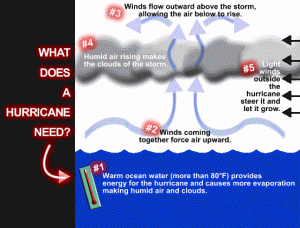On the anniversary of Hurricane Katrina, on the tail end of Hurricane Irene, and with “tropical depression #12” starting to gain momentum, we thought you might want some resources and lessons for teaching about hurricanes. Here’s a list to get you started:
- NASA’s Hurricane Resources Page – Track Irene’s progress through NASA’s updates and video gallery.
- Hurricane Irene: 12 Ways to Track the Storm Online – Amazing (“terrifying beautiful”) views of Irene from space.
- Irene Roars Up the Coast – Excellent infographic from the Washington Post.
- USA Today’s Resources: Hurricanes – Resources include a section on “Graphics to Help You Understand Hurricanes.”
- National Hurricane Center – Good starting point for tracking current hurricane activity.
- From Thinkfinity – If you’re looking for lessons on teaching about hurricanes, here comes http://www.thinkfinity.org/hurricanes – a great collection of lessons, with descriptors and grade levels included. There are several more resources that will come up on a Thinkfinity search on “hurricanes” that are not listed on the above site:
- From Thinkfinity’s Science Netlinks partnership, we like the e-Sheet lesson (for grades 3-5) on Tracking Hurricanes. The lesson includes a link to the National Hurricane Center’s DAS Tropical Cyclone Tracker – from which you can even link to the option of viewing the map in Google Earth.
- Also from Science Netlinks, via the Thinkfinity search engine, we like the Science of Hurricanes lesson, which provides archived NASA video footage on Hurricane Andrew.
- From National Geographic, via the Thinkfinity search engine, we really like the What Happened to Whom lesson (for grades 6-8). The lesson has a link to another National Geographic lesson: Stormy Stories. Too often for our students, it’s hard to relate to the horrific scale of natural disasters because the numbers are simply too huge, too exponential to relate to. Here’s where the story of one child providing a personal account of a disaster can really help students relate to the human cost – and truly develop empathy for those who have lived through a natural disaster.
- From Read/Write/Think, a lesson to help students to explore the nature and structure of expository texts that focus on cause and effect: Exploring Cause and Effect Using Expository Text about Natural Disasters (for grades 3-5).
- Exploring Weather – “A comprehensive website that explores all of the different kinds of weather from hurricanes to winter storms.” The Hurricanes page, for example, includes general information, charts, animations, and graphics, including the one below (for grades 3-8):
- Created in the Path of Irene … An Invitation – Eye of the Storm author Kate Messner invites teachers and librarians to get the word out to students to join a Hurricane Irene collaborative writing experience:
… This storm is poised to affect millions of us, all up and down the East Coast. So here’s the invitation part…
Write or draw something as the storm passes through. Maybe by flashlight or candlelight while the power is out…maybe in between trips downstairs to bail out the basement. And then, let’s gather all that writing and art together to see what people created as Hurricane Irene passed through.” (for ALL grades!)
If you have any resources to add, please post a comment!


